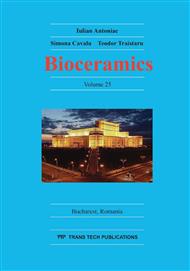p.43
p.52
p.56
p.63
p.69
p.74
p.80
p.86
p.93
Phosphating of Calcium Carbonate for Obtaining Hydroxyapatite from the Ostrich Egg Shell
Abstract:
The Hydroxyapatite (HA), the major component of the inorganic portion of bones, may be obtained from different sources for use as biomaterial in the reconstruction of critical bone defects. Among these resources, the eggshell appears as a promising alternative since it is a waste material which may be reused as a source of calcium carbonate after adequate treatment, giving rise to mineral hydroxyapatite. After morphological and physicochemical adjustments allowing its standardization and utilization, hydroxyapatite (HA) may turn into a potentially useful biomaterial for different experimental purposes. This paper aims to present a viable method for obtaining a hydroxyapatite from Ostrich eggshell by wet precipitation process. This phosphating technique with emphasis on the issue of sustainable reuse of disposable materials allows the production of a synthetic crystalline material with characteristics similar to those of bone and tooth. The structural characterization was performed by X-Ray diffraction and scanning electron microscopy with field emission gun and energy dispersive X-ray in the Military Institute of Engineering.
Info:
Periodical:
Pages:
69-73
Citation:
Online since:
November 2013
Price:
Сopyright:
© 2014 Trans Tech Publications Ltd. All Rights Reserved
Share:
Citation:


